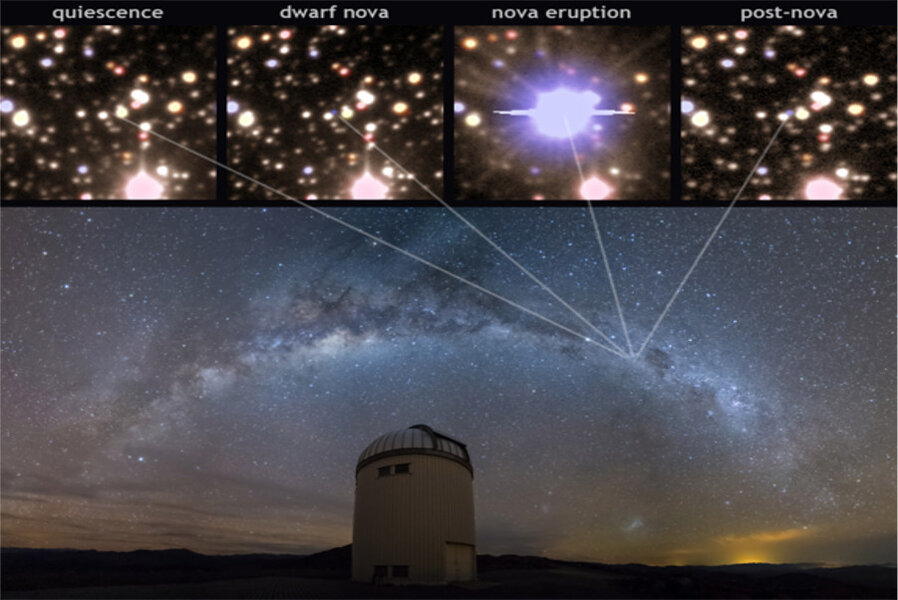For the first time ever, astronomers watch a sleeping white dwarf go nova
Loading...
Maybe Sleepy Dwarf was the star of the story all along.
After years of careful observations, a team of Polish scientists have watched a white dwarf emerge from hibernation, steal enough mass from its companion star to go nova, and then return to sleep.
Astronomers at the Optical Gravitational Lensing Experiment (OGLE) — a long-term surveying project using microlensing to search for dark matter — have now witnessed, for the first time in recorded history, a white dwarf going from its pre- to post-nova phases, thus providing the first-ever visual record of the steps of the cataclysm that gives cataclysmic variable stars their name. They detailed their findings in an article published Wednesday in the journal Nature.
A white dwarf is the remnant core of a star that used up all its nuclear fuel. After its collapse, this one settled into a binary system with a companion star whose mass it slowly steals.
The stolen mass (primarily hydrogen) orbits around the white dwarf in a loose disk. Because of the slow rate of theft, which scientists refer to as "mass transfer," the star-stuff occasionally becomes unstable and explodes in small "dwarf novas." (Like a spinning top, mass transfer is more stable at higher speeds.)
Dwarf novas fling the hydrogen down onto the surface of the white dwarf, where it builds up until it erupts in a thermonuclear explosion known as a classical nova.
Starting in 2003, the research team tracked several dwarf novas, and then in 2009, enough mass had gathered on the surface of the white dwarf to begin fusing into a full classical nova.
According to the hibernation hypothesis, white dwarfs emerge from hibernation, start stealing hydrogen at a low, unstable rate, go nova, then have several centuries of high-rate mass transfer before settling into another long hibernation period, anywhere between 1,000 and one million years long. After that, the white dwarf would awake and resume stealing hydrogen at pre-nova levels, causing an altogether new nova to occur.
What the astronomers at OGLE began observing in 2003 was the white dwarf awakening from its hibernation stage and resuming the mass transfer, observed as a periodic brightening from dwarf novas, culminating in a nova in 2009 (called V1213 Cen, or Nova Centauri 2009), when the white dwarf was briefly 10,000 times brighter than it had been during hibernation.
Now, seven years after the nova, the white dwarf remains 100 times brighter than it had been during its pre-nova hibernation, with no signs of dwarf novas, suggesting a much higher mass transfer rate – and confirming the steps of the hibernation model.
In other words, by watching V1213 Cen for 12 years, the astronomers gathered direct evidence to confirm the existence of the pre-nova and post-nova hibernation stages.
Unlike supernovas, in which stars die, these classical novas can just keep repeating – as long as the white dwarfs don't grow beyond a critical threshold. So after a few hundred years of high mass accretion, the white dwarf will settle into another hibernation period and the cycle will begin again.
And none of this was the team's original goal. The researchers at OGLE are searching for dark matter in the universe — the term for the roughly 80 percent of the mass which is made up of materials scientists have never been able to directly observe. Dark matter recently made news when a team of scientists in Hungary, also attempting to observe dark matter, discovered what they believe to be a fifth fundamental force of nature.
However, what the scientists at OGLE recorded in the six years before and after a classical nova signals a breakthrough confirmation of scientific theory on how cataclysmic variable stars function and the exact method by which classical novas occur.






